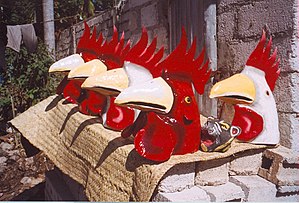Papier-mache paste is the substance that holds the paper together. The traditional method of making papier-mache paste is to use a mixture of water and flour or other starch, mixed to the consistency of heavy cream. While any adhesive can be used if thinned to a similar texture, such as polyvinyl acetate (PVA) based glues (wood glue or, in the United States, white Elmer's glue), the flour and water mixture is the most economical. Adding oil of cloves or other additives to the mixture reduces the chances of the product developing mold. The paper is cut or torn into strips, and soaked in the paste until saturated. The saturated pieces are then placed onto the surface and allowed to dry slowly; drying in an oven can cause warping or other dimensional changes during the drying process. The strips may be placed on an armature, or skeleton, often of wire mesh over a structural frame, or they can be placed on an object to create a cast. Oil or grease can be used as a release agent if needed. Once dried, the resulting material can be cut, sanded and/or painted, and waterproofed by painting with a suitable water repelling paint
STORY
08:56
In ancient Egypt, coffins and death masks were often made from cartonnage - layers of papyrus or linen covered with plaster
In Persia and Kashmir, papier-mache has been used to
manufacture small painted boxes, trays, étagères and cases.
Japan and China also produced laminated paper articles
using papier-mache. In Japan and India, papier-mache
was used to add decorative elements to armor and shields.
Starting around 1725 in Europe, gilded papier-mache began to appear as a low-cost alternative to similarly treated plaster or carved wood in architecture. Henry Clay of Birmingham, England, patented a process for treating laminated sheets of paper with linseed oil to produce waterproof panels in 1772. These sheets were used for building coach door panels, amongst other structural uses. Theodore Jennens patented a process in 1847 for steaming and pressing these laminated sheets into various shapes, which was then used to manufacture trays, chair backs, and structural panels, usually laid over a wood or metal armature for strength. The papier-mâché was smoothed and lacquered, or finished with a pearl shell finish. The industry lasted through the 19th century.Russia had a thriving industry in ornamental papier-mache. A large assortment of painted Russian papier-mache items appear in a Tiffany & Co. catalog from 1893.Martin Travers the English ecclesiastical designer made much use of papier mache for his church furnishings in the 1930s.
Papier-mâché has been used for doll heads starting as early as 1540, molded in two parts from a mixture of paper pulp, clay, and plaster, and then glued together, with the head then smoothed, painted and varnished
One common item made in the 19th century in America was the paper canoe, most famously made by Waters & Sons of Troy, New York. The invention of the continuous sheet paper machine allows paper sheets to be made of any length, and this made an ideal material for building a seamless boat hull. The paper of the time was significantly stretchier than modern paper, especially when damp, and this was used to good effect in the manufacture of paper boats. A layer of thick, dampened paper was placed over a hull mold and tacked down at the edges. A layer of glue was added, allowed to dry, and sanded down. Additional layers of paper and glue could be added to achieve the desired thickness, and cloth could be added as well to provide additional strength and stiffness. The final product was trimmed, reinforced with wooden strips at the keel and gunwales to provide stiffness, and waterproofed. Paper racing shells were highly competitive during the late 19th century. Few examples of paper boats survived. One of the best known paper boats was the canoe, the "Maria Theresa," used by Nathaniel Holmes Bishop to travel from New York to Florida in 1874–1875. An account of his travels was published in the book "Voyage of the Paper Canoe.
Creating Papier-mâché masks is common among elementary school children and craft lovers. Either one's own face or a balloon can be used as a mold. This is common during Halloween time as a facial mask complements the costume.




